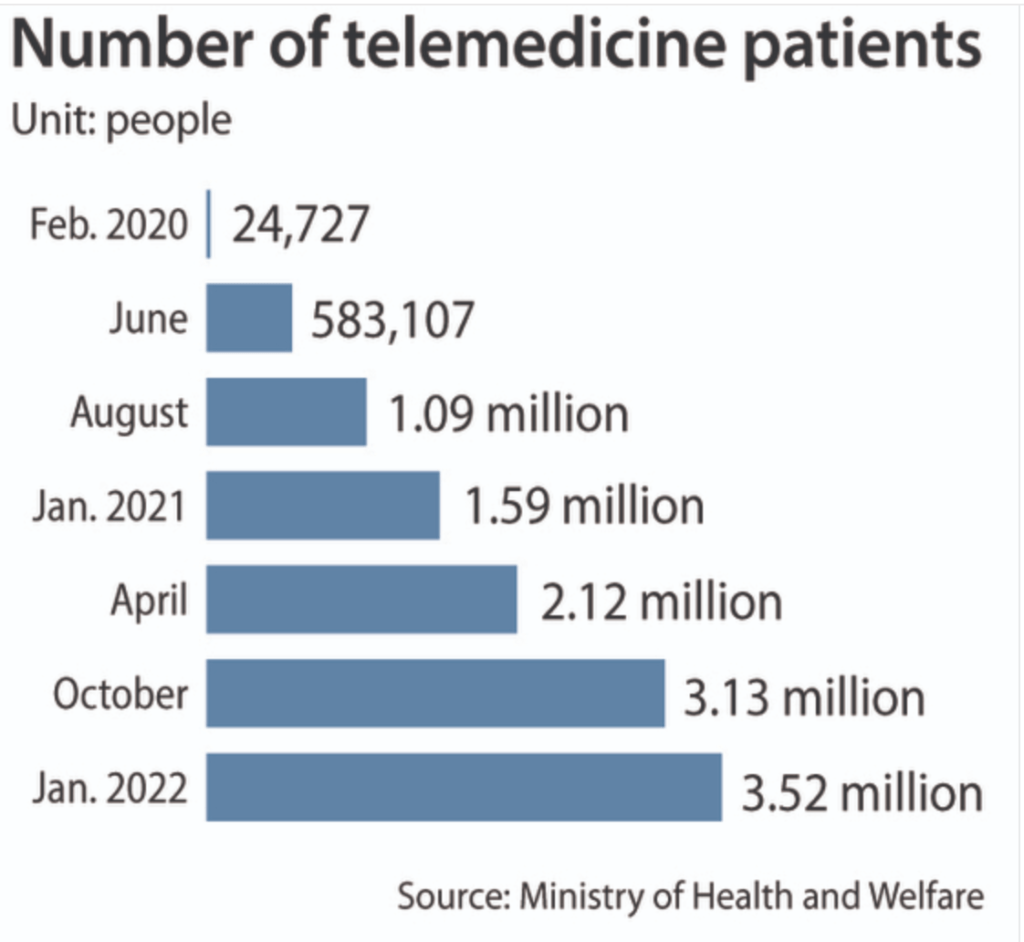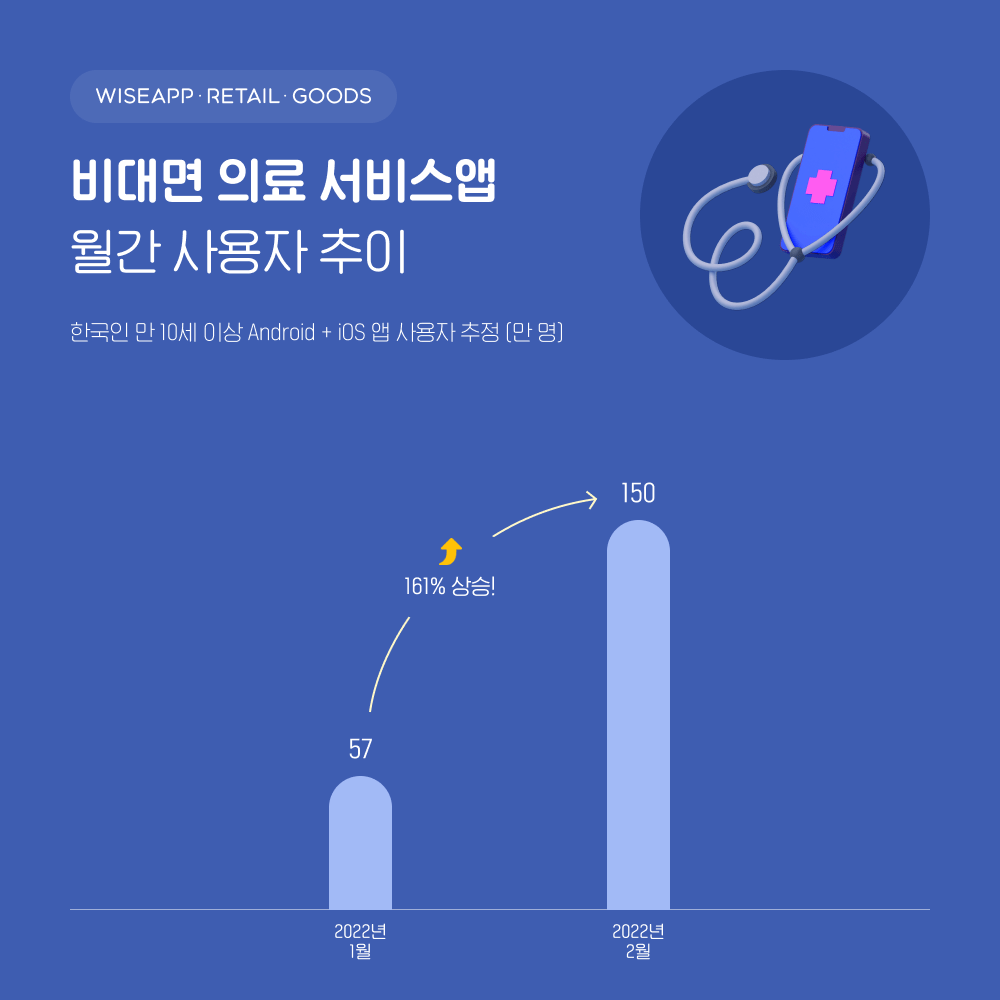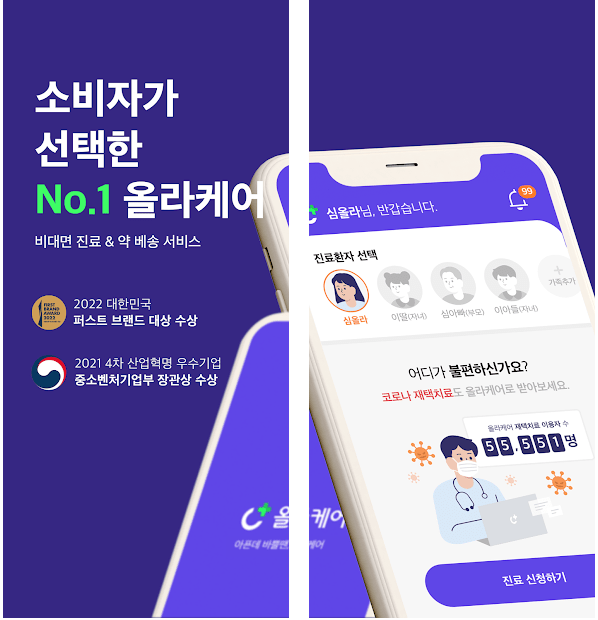The last two years have been challenging for healthcare with the outbreak of COVID-19. It gave rise to innovation in health tech and interest in apps that provide non-face-to-face treatment and medical services.
‘Non-face-to-face medical service’ refers to a service that provides overall medical activities ranging from remote to non-face-to-face medical treatment and drug prescription using interactive information and communication technology. Since the Ministry of Health and Welfare temporarily authorized telemedicine in Korea in February 2020, the industry is booming, and telemedicine startups are flourishing. There are around 20 startups that offer telemedicine services in Korea.
According to data published by the Ministry of Health and Welfare, some 3.52 million patients have experienced telemedicine as of January 2022. That’s up 1,500 percent in just two years since 25,000 in February 2020, the month telemedicine was allowed by law.

Wise App survey reveals usage
As a result of a sample survey of Korean smartphone users (Android + iOS) aged ten years or older in February 2022, the number of users who used major non-face-to-face medical service apps such as Dr. Now, OllaCare, and GoodDoc at least once was 4,942 Korean smartphone users aged ten years or older. It is estimated that about 3% of 10,000 people used it, and the related figure is expected to show a continuous increase in line with the spread of COVID-19 in the future.
The non-face-to-face medical service app used by the most people across all generations was ‘Dr. Now’, which was used by 530,000 people in February, while 520,000 people used ‘Goodoc’ and 450,000 people used ‘OllaCare’.

For all non-face-to-face medical service apps, the proportion of female users was high, and by age, OllaCare in the 10 to 20s, Dr. Now in the 30s, and Goodoc in the 50s and older generation were high.
The survey is based on a sample survey of Android and iPhone smartphone users aged 10 years or older by the app/retail analysis service Wise App Retail and Goods. Apps that only provide reservation and reception services were excluded from this study.
In addition, the study estimated the number of people who used an individual non-face-to-face medical service app at least once in February for non-face-to-face medical service apps on Google Play and App Store.
The Apps used for the survey
For Dr. Now, the number of users of the telemedicine platform exceeded 900,00 in February 2022, and the number of app downloads was about 600,000. Since December 2020, when the non-face-to-face treatment-prescription drug delivery service was launched, the cumulative number of users has exceeded 2.3 million, and the cumulative number of app downloads has surpassed 1.4 million. In addition, it ranked first in the popularity rankings in two major app markets, such as Google Play and Apple App Store, and has a total of 20,000 reviews left by users, giving it a rating of 4.6 (out of 5).

Dr. Now is affiliated with the largest number of medical staff in the industry, with more than 600 medical institutions nationwide. Among them, the proportion of specialists in hospitals and hospitals reached 50%. As non-face-to-face treatment became popular, the number of treatment cases increased about 108 times compared to February last year. Currently, there are 19 selectable medical subjects in Dr. Now, including pediatrics, otolaryngology, dermatology, obstetrics and gynecology, and urology, focusing on enhancing user convenience.
Dr. Now CEO Jang Ji-ho said, “Since we introduced non-face-to-face treatment and prescription drug delivery services, we have been growing at an average of 30% or more every month. We are doing our best,” he said.

Goodoc, a search/reservation service for medical services in the country, saw its monthly active users (MAU) reach 247,358 in January 2022, up 30.2 percent from a year before, according to the data tracker IGAWorks. Goodoc is a Korean smartphone app launched in 2012 providing medical services such as information on doctors, their rates, contact numbers, and more. For Goodoc the user has just to enter symptoms and will be matched with a doctor near by.

Ollacare is offering a similar remote medical service. Established in July 2021, the app has over 190,000 monthly active users as of the end of December, 2021 up 400 percent on month. Ollacare matches patients with medical staff and specialists within five minutes. It also offers medicine delivery service through its staff. The app also provides convenient prescription drug delivery services from direct pharmacy visits to direct delivery and nationwide delivery.
Patients welcome telemedicine
Absence of clear guidelines has attracted some resistance regarding telemedicine from the medical and pharmaceutical industry, but the growth of remote medicine services in last two years means it might not be easy for the government to ban non-face-to-face medical diagnosis even after the end of the pandemic. Though the telemedicine ban has been temporarily lifted, patients welcome the convenience.
According to a survey by Korea Startup Forum’s body specializing in telemedicine on 1,000 people, 66.1 percent of respondents felt positive about telemedicine. Some 68.4 percent said they would like to experience a telemedicine service in the future. Around 82.5 percent of people who said they have positive views on telemedicine picked “saving cost and time” as the biggest advantage. Fifty-one-point-four percent said it helps reduce the risk of being infected by new diseases during a visit to hospitals.
Also Read,
- N-Finders Co., Ltd: The Korean startup advancing in the regenerative medicine field
- BiLabs: Revolutionary Technology in Cardiopulmonary Medicine
- Korean startup Mediaiplus uses AI & big data analysis to ease clinical trial process for new drug development
- Orum Therapeutics’ new medicines can treat cancer and assist in genetic diseases






